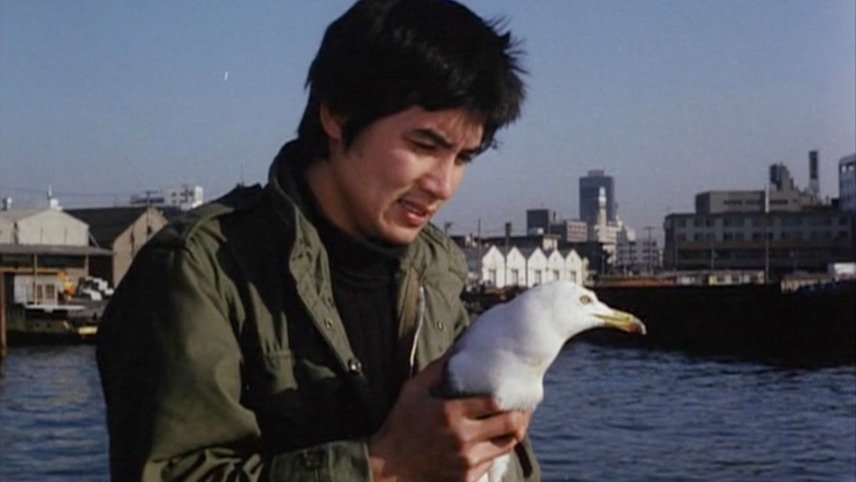
Katsuo is a young man on the run from his hometown, that has a population which revolves around the mining industry that is virtually collapsing, so he relocates to Tokyo where he eventually becomes a high rise windows cleaner. But before that, he actually worked at a dump truck company, where we first meet him “humoring” a widow who wanted a sequel to her recently deceased husband who bore a close resemblance to him. From here on, the story features him watching a young office worker straightening out her stockings in an otherwise unoccupied office. This touches him and he grabs the chance to pursue her, Kumi, who in the meanwhile is running away from life in the fishing village and a relative who wanted to marry her. Though his intentions seem honorable, Kumi who rarely goes out without Ayako, one of her colleagues engaged to the man of her dreams, and who in many ways sees Tsukasa as a stalker rather than a pursuer, is not impressed and literally slaps him in the face.
He won’t let go, and eventually, she relaxes her defenses, and they become a couple. However, his outlandish fantasies of a city called Resiporuko and her slightly more rational dreams of living the dream in the city they are in, do get out of sync, in a matter of weeks to be exact. A scene involving a coast bird while they are at a beach exposes their variability further, yet they persist in being together, again, in the aftermath of the girl’s “trauma” of dealing with his dismissive mother. It seems, though, that love in their case is destined to end up with both of them being broken and destroyed.
Uncontroversial Information, Katsuo’s pursuit of Kumi, and even more Kumi falling prey to his obsessive tracking him is hard to suggest especially with the era where ATG films were made as the norm, is believable, even normal to imagine happening in ATG films. That aside, the slightly grim darker nature of the film is used by Kenji Yoshida to deliver analysis about the characters, the relationship of the two and sociopolitical discussions even political commentary as well.
With regard to the first element, the “pokes” regarding the mining industry and the dump truck one are very persuasive and they have been unjustly regarded us low paying and actually risky, in two remarks though, which are somehow too forcibly interwoven in the plot. So with the mining, whose reduction at some rate accounts for Katsuo’s greatly today’s wealth and family situation and also makes a remark on the reasons for the development of urban centers, where youngsters could (do actually) have better conditions for living in, at least for the time being, still has its advantages.
This last remark indeed touches upon Kumi’s life as well, who, for her, is even worse, for feminism which has a more unjust attitude to women than patriarchal Japan, especially exacerbated in Aoi adolescent boys. His father and grandfather advance this patriarchal notion in the fisherman’s village and Katsuo and others actually bear their weight too. Her friend also operates in more or less that way, virtually asserting that women in those days had to get married well to be able to live and with her choice Kumi more or less shapes what she wishes to achieve.
It looks like Yoshida implies that love can help heal one’s wounds, however it would only be a temporary fix as ‘love’ is just an idea that deteriorates both protagonists once they make attempts to understand one another while there is a constraint of staying together. Yoshida deals with the inner city as barren wasteland where these two young adult protagonists (or turning into adults as you like) reside as Yoshida sits along to fuel their hopelessness with one deadlock after another. The issue of their parents being irrelevant and oppressive forces in their lives creates the same shift, which in this case, was in the words and actions of young people, directed towards the previous generation.
There is, however, a part of the movie where Yoshida goes overboard and the last part of the film tends to get a little cheesier than compare to the rest of the movie. In my opinion, the way the movie was put together was unnecessarily overly dramatic. There were indeed, several mini-dramas towards the end which simply was not needed. The lack of measure was addressed by the use of a relatively fast pace throughout the film which in my opinion was the reason why the film started to feel a little dragged out.
Both Ken Tanaka And Yoko Takahashi were able to portray their characters very well, especially in the courting scene, they both embraced the feistiness of the characters really well which allowed them to include the burdens from the past smoothly. Sadly, the relationship between the two and how Yoshida portrayed that relationship started to get stale too quickly and their sense of drama sort of started to annoy me towards the end of the film.
As for Koshiro Otsu’s cinematography and filming, seagull scenes looking at the different poles of the sail are pretty well done. The shot of the sun, the horizon, and the moving clouds is also done beautifully. It is also important to note that the filmmakers expressed their desire to say that permission was obtained to use birds in the movie.
Seagull, Have You Seen The Blinking Ocean? An Encounter, is an average film as it is overrated as one. Like the rest of the ATG creations, it definitely is on a lower level, however, the shooting is done well but the comments are interesting but lacking in a sense of measure.
For more movies like Oh Seagull, Have You Seen the Sparkling Ocean? An Encounter (1975) visit solarmovie







